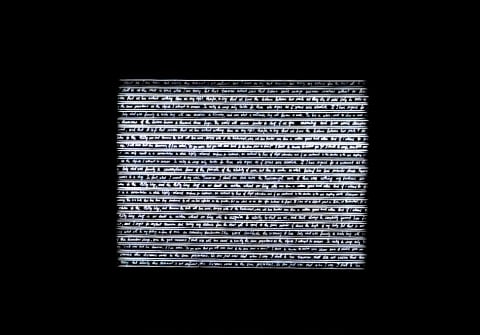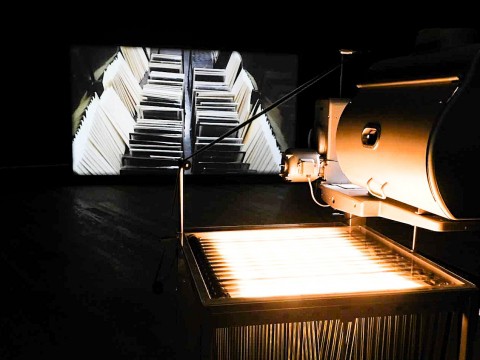The Remai Modern has opened up a new exhibit — and a multitude of other projects — from internationally renowned artist and filmmaker Rosa Barba. Barba is a German-Italian visual artist who uses film and its physical properties to create filmic sculptures.
Part of Barba’s work is cinematic, but projectors, filmstock and light are used to expand the artwork beyond the screen and into the physical space of the gallery. In addition to filmic sculptures, Barba also creates experimental films and publications about cinema.

“Sight Enables us to Appreciate Distance” by Rosa Barba, displayed at the Remai Modern on Sept. 28.
The main focus of Barba’s collaboration at the Remai is a new exhibit entitled Send Me Sky. Currently being shown in the Feature Gallery on the third floor, the exhibit is presented in low light and consists of experiments — bringing the cinematic into contact with physical space.
The centrepiece of Send Me Sky is the newly commissioned Send Me Sky, Henrietta, which consists of a projector displaying film inspired by the work of astronomer Henrietta S. Leavitt. The ribbons of filmstock are on display through a window in the base of the projector, mirroring the images being projected against the canvas and breaking the film into individual frames.
The work of women in the sciences is one of the inspirations for Send Me Sky, Henrietta. Barba compares the work historically done by women in astronomy to that done by an editor of a film.
“I filmed the astronomical photographic plates that were shot with the great refractor at Harvard more than a hundred years ago and then examined by these women that were hired by Harvard to work as computers — they even called them computers,” said Barba. “They worked almost like editors — really just focused on understanding slight differences in light.”
Barba intends the sculpture to pay tribute to Leavitt’s contributions to the sciences, with a specific focus on her discovery of variable stars — stars that vary intermittently in their brightness.
“This piece is specifically based on the discovery [by] one of these astronomers called Henrietta Swan Leavitt, who actually discovered that there are stars that are flickering. These flickering stars were used as measuring sticks to measure the universe, and suddenly, the universe was so much larger than everybody [thought] before,” said Barba.
Barba also sees parallels between her own work and the science of astronomy. As an artist, she hopes to expand on what we already know about film and the language of cinema.
“We don’t have a lot of knowledge about it. As an astronomy student, you basically learn already in the first year the full percent of knowledge that we have, and everything else is speculation and research. For me, I like to look at my cinematic research in that way, too. I’m trying to break the status quo of this kind of classical cinema,” Barba said.
Amongst the other pieces on display is the playful Language Infinity Sphere, which features a steel sphere covered in typewriter pieces and two canvas sheets which display ink prints created with the sculpture itself. The hypnotic Sight Enables Us to Appreciate Distance uses 70 mm film, motors and light to create a transfixing atmosphere.

“Language Infinity Sphere” by Rosa Barba, displayed at the Remai Modern on Sept. 28.
In addition to the exhibit, Barba also worked to bring her White Museum series to Saskatoon. White Museum has previously been shown in New York and Brussels. The project uses light from a projector to highlight the surrounding space, transforming the landscape of the city itself into a cinematic experience.
“When I got here in January, I was very intrigued, and I loved the building facing the river. I read and researched a bit about the history of the South Saskatchewan River, which is such a very layered historical force,” said Barba. “The idea [was] to make this piece here that illuminates part of the river and extends the cinematic space from the museum to the river.”
Barba’s collaboration with the Remai continues beyond the gallery space and into the museum’s Sasktel Theatre. Patrons will be able to see Barba’s 2016 experimental film Disseminate and Hold. Barba’s long-form cinematic works are concerned with exploring how cities and city infrastructure tell cyclical stories.
“The main protagonist [of the film] is the elevated highway Minhocão, which was built during the dictatorship in São Paulo, and is kind of, for me, treated as a storage medium, where all of this dictatorship and history is stored and then freed up again,” said Barba.
For those with an interest in film who long to see the world outside the frame as a cinematic experience, Rosa Barba’s Send Me Sky is a can’t miss new showing from the Remai. The exhibit will remain open until January 13, 2019.
—
Cole Chretien / Culture Editor
Photos: Olena Malko